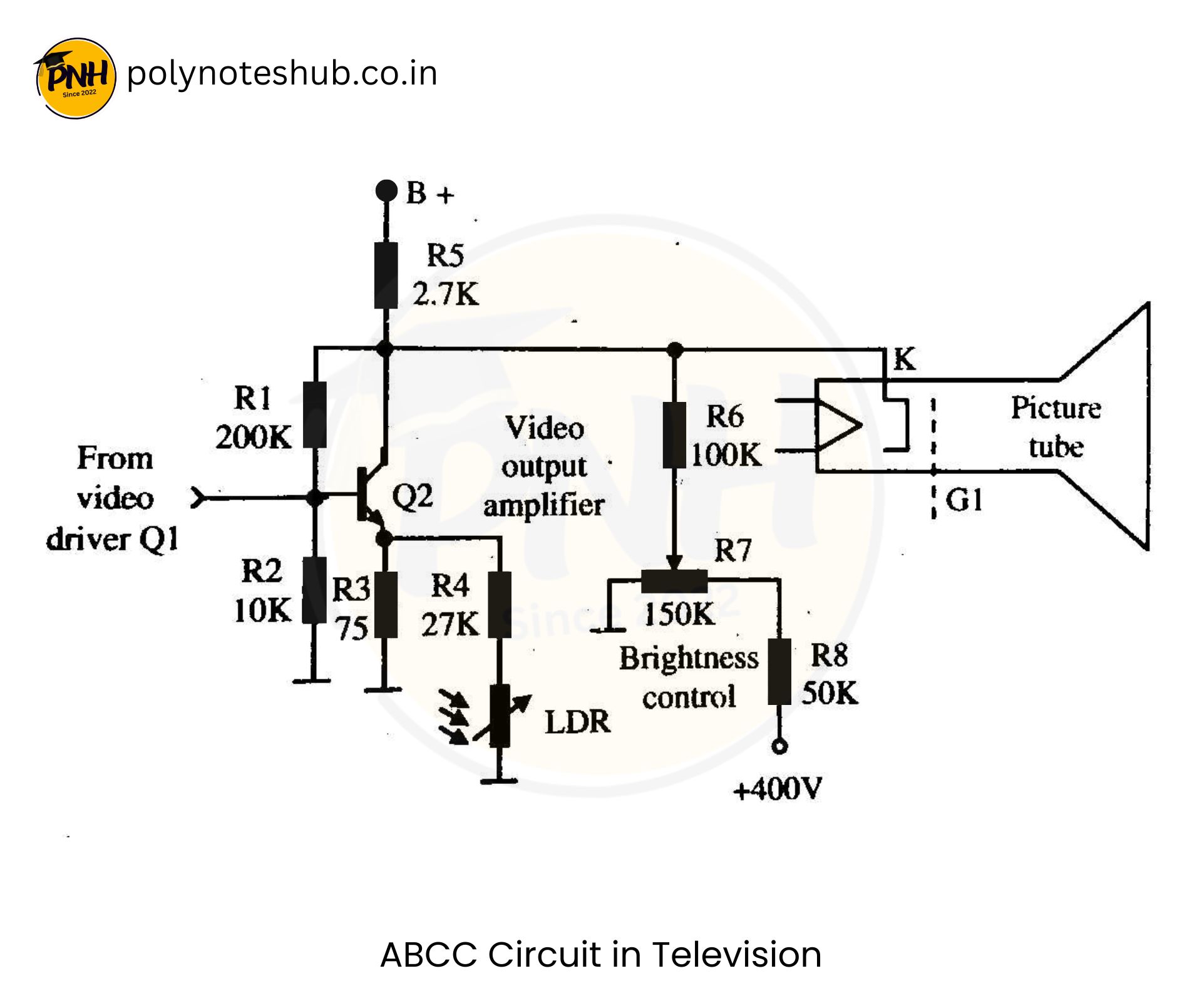In this note, we are going to know about the Automatic Brightness and Contrast Control Circuit in TV or Television. Welcome to Poly Notes Hub, a leading destination for engineering notes for diploma and degree engineering students.
Author Name: Arun Paul.
Automatic Brightness and Contrast Control Circuit in TV
Brightness Control adjusts the screen’s overall brightness (light intensity). It influences whether the images appear dark or bright on the screen.
Contrast control on a television alters the contrast between the brightest and darkest regions of an image, improving visual clarity and depth. It controls the amplitude of the video stream, which influences how bright the white and black levels look on the screen. A higher contrast setting sharpens the distinction between light and dark areas, making the image appear more vibrant, whereas a lower contrast setting produces a softer, more muted display. Proper contrast adjustment increases detail visibility and the overall viewing experience, particularly under changing lighting circumstances.
Some television receivers contains a simple circuit which automatically adjusts brightness and contrast in response to change of ambient light conditions. The operation of such a control depends on the characteristics of the LDR (light- depends resistance) which forms part of the video amplifier circuit. The LDR is a photoconductive device whose resistance varies inversely with the intensity of light striking its active material. It is mounted on the front panel of the receiver.
A Simplified video amplifier circuit showing how both brightness and contrast may be automatically controlled by a single LDR is shown in Fig.

Circuit Description of Automatic Brightness and Contrast Control Circuit in TV
This circuit diagram represents the Automatic Brightness and Contrast Control (ABCC) circuit used in televisions to regulate the screen brightness and contrast dynamically based on ambient lighting conditions.
- Video Driver (Q1): Provides the video signal input to the ABCC circuit.
- Transistor (Q2 – Video Output Amplifier): It acts as an amplifier to boost the video signal before it reaches the picture tube and ensures the signal is strong enough for proper display.
- Resistors (R1, R2, R3, R4, R5, R6, R7, R8): Help in biasing the transistor and controlling signal strength.
- Light Dependent Resistor (LDR): Adjusts brightness automatically based on ambient light. When the surrounding light is bright, the LDR’s resistance decreases, reducing the brightness.
- Brightness Control (Variable Resistor/Potentiometer): Allows manual adjustment of brightness along with automatic control from the LDR.
- Picture Tube (CRT Display): Displays the final output image. The brightness and contrast are adjusted by controlling the signal at grid G1 and cathode K of the picture tube.
Functions of Automatic Brightness and Contrast Control (ABCC) circuit in a TV
- Adjusts Brightness Automatically
- Enhances Contrast Dynamically
- Maintains Consistent Picture Quality
- Reduces Power Consumption
- Prolongs Screen Life
Working of ABCC Circuit in Television
The operating concept of this Automatic Brightness and Contrast Control (ABCC) circuit begins with the visual signal input from the video driver Q1, which is then supplied into the transistor Q2. This transistor functions as a video output amplifier, boosting the signal before it is transferred to the picture tube.
The circuit has an automatic brightness control mechanism based on a Light Dependent Resistor (LDR). The LDR senses ambient lighting levels and changes the brightness accordingly. When the ambient light is bright, the LDR’s resistance drops, resulting in a lower screen brightness. In contrast, in low-light conditions, the resistance of the LDR increases, increasing the display’s brightness.
The contrast and brightness regulation occurs as the amplified signal passes through R6 (100K) to the cathode (K) of the picture tube. Meanwhile, the brightness control circuit, consisting of R7 (150K) and R8 (50K), along with the LDR, adjusts the voltage at G1 (the grid of the CRT). This regulation ensures that both contrast and brightness are dynamically modified to optimize the viewing experience.
Finally, the modified signal is displayed on the CRT screen, with ideal brightness and contrast dependent on the lighting circumstances. This method provides a more comfortable and adaptable viewing experience by automatically adjusting to different lighting conditions while also allowing manual brightness control if necessary.

